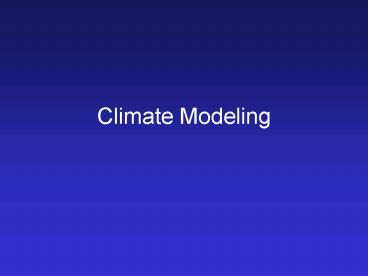Climate Modeling PowerPoint PPT Presentation
1 / 37
Title: Climate Modeling
1
Climate Modeling
2
Need for Models
- Laboratory to perform experiments
- Way to understand complex connections, including
feedbacks - Way to predict what will happen in the future
3
Building a Model
- What is needed
- Framework (time space)
- One or more specific questions to be addressed
- Appropriate type of model
- Mathematics describing the model
- Powerful computer
- Validation data set
4
Types of Climate Models
- Conceptual models
- Diagnostic models
- Prognostic models
5
Conceptual Model
6
Diagnostic Models
- Quantitative model
- Use measured data (input) to determine another
quantity (output) - No future prediction involved
- Example use observed temperature, wind,
humidity to determine current or past
precipitation
7
Diagnostic Model
8
Prognostic Models
- Quantitative model
- Use measured data to determine another quantity
AND make a prediction - Examples
- Atmospheric GCMs
- Coupled GCMs
- Regional climate models
9
Time and Space
- Spatial domain
- Global
- Regional
- Spatial resolution
- Grid
- Temporal predictions
- Depends on response time of system
- Years to 1000s years
- Time scale of integration
- How long conditions act on the system until new
conditions are calculated - Minutes to days
10
(No Transcript)
11
Temporal Scales of Predictions
- Paleo-climatological predictions
- 1,000 to 100,000 years
- Pangea
- Long-term predictions
- Decades to centuries
- Global warming
- NAO
- Medium-term predictions
- Years
- ENSO
12
Concept of Numerical Modeling
- Mathematical representation of processes
- Equations describing evolution with time
- Integration of equations with time
13
Models are a Simplification
- Climate system is complex
- Climatic processes limited by
- Understanding
- Computational ability
- Temporal spatial resolution limited by
- Data availability
- Computational ability
14
Parameterization
- Representing processes in a simpler way
- Ignoring processes that have little impact on
climate at the chosen scale - Avoids unnecessary computing time
- Mutual consistency is required
- If two processes produce feedbacks with opposite
signs, one should not be considered without the
other
15
Say youre building a climate model you want to
include clouds
Model needs to include the effect of clouds on
both LW SW
LW
SW
-
16
Uncertainty of Results
- Results have inherent uncertainty
- Initial conditions based on observational data
- Observational data may be
- Incomplete
- Inaccurate
- Results are only as good as model initial data
17
GCMs
- General Circulation Models or Global Climate
Models - More elaborate than other climate models
- Models three-dimensional characteristics of
climate - Physical geography plays important role
- Involves labor-intensive calculations
18
Coupled GCM
- Models the coupling of ocean-atmosphere
interactions - Ocean-atmosphere interface exchanges
- Heat
- Water
- Momentum
19
Coupled Ocean-Atmosphere
20
Coupled Ocean-Atmosphere
- Wind drives ocean circulation
- Heat moisture from ocean influence atmospheric
circulation weather - Rain alters ocean salinity, therefore ocean
circulation
21
Areas of Research
- GCMs are being used to explore
- Increasing atmospheric CO2 concentration
- Reoccurrence of a Little Ice Age
- Future climates impact on marine life
- Air pollution the Southeast Asian monsoon
- Rain season prediction for crop planting in the
Amazon basin
22
Expectations for Future GCMs
- Finer-scale to include
- Large-scale eddies in ocean
- River flow detail
- Surface feature detail
- More extensive modeling of natural processes
- carbon cycling between land, ocean, atmosphere
23
Educational Global Climate Model (EdGCM)
- Prognostic model
- Models 3-D features of climate system
- Global spatial domain
- Coupled ocean-atmosphere
24
How EdGCM Works
- Numerically solves equations for. . .
- Physical conservation of
- Energy
- Mass
- Momentum
- Moisture
- Equation of State (pVnRT)
- Billions of calculations for each year
25
EdGCM Calculations
- Calculations take into account
- Seasonal diurnal cycles
- Aerosols
- Relevant gases
- Large-scale convective cloud cover
- Precipitation
- Snow depth
- SST
26
EdGCM Spatial Resolution
- Horizontal 8 latitude by 10
longitude - Vertical 9 layers in atmosphere
27
EdGCM Temporal Resolution
- Calculations performed for every 30 min
- Output may be analyzed by
- Month
- Season
- Year(s)
- Lab explores global warming
- long-term prediction
- 50 100 year runs
28
EdGCM Input
- Land surface condition
- Start end dates of run
- SST mode (observed or predicted SST)
- Solar luminosity
- GHG concentrations
- Solar and/or GHG trend (optional)
29
EdGCM Output
- Global data for 400 climate variables,
- including
- Temperature
- Albedo
- Wind
- Snow cover
- Cloud cover
30
Analysis Options
- Summary tables
- Time series plots
- Maps
- Vertical profiles
- Anomaly maps profiles
- User chooses temporal scale
- Interpolation option
31
(No Transcript)
32
(No Transcript)
33
(No Transcript)
34
(No Transcript)
35
(No Transcript)
36
(No Transcript)
37
(No Transcript)

